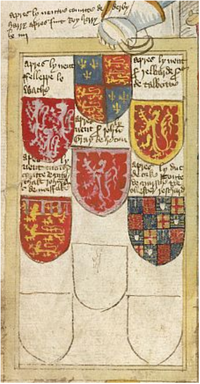File:BrugesGarterBook ArmsOfSuccessorKnights.png

Original file (1,740 × 3,640 pixels, file size: 10.05 MB, MIME type: image/png)
Captions
Captions
Contents
Summary[edit]
| DescriptionBrugesGarterBook ArmsOfSuccessorKnights.png |
English: Compilation of images of boards displaying arms of the successor knights to each of the 25 Founder Knights of the Order of the Garter, founded in 1348. First number is the ordinal number of the Founder Knight whose hand supports the board, followed by folio number per British Library catalogue.
Further information on the names of the successor knights and their arms see:
Inscriptions
Edmund Horace Fellowes, Stall-Plates of the Knights of the GarterFrom Edmund Horace Fellowes: The Knights of the Garter, 1348-1939. With a complete list of the stall-plates in St. George's chapel; London, Published for the dean and canons of St. George's chapel in Windsor castle by the Society for promoting Christian knowledge, 1939. (See https://www.heraldica.org/topics/orders/garterstalls.htm ) Stalls of the Earlier Knights These lists show the succession of the knights from 1348 to 1509 in each stall. The dates are those of election, since rarely are investitures and installation dates known. When a knight was transferred to a different stall, the original date of election is between square brackets. Those knights whose plates are still in the stall are marked with a * (113 out of 264). The stalls are numbered the old way, with Fellowes' numbering between parentheses. The Sovereign's Stall 1 (S.1)No plates
Stall 2 (N.1)
Stall 3 (S.3)
Stall 4 (N.3)
Stall 5 (S.5)
Stall 6 (N. 5)
Stall 7 (S.7)
Stall 8 (N.)
Stall 9 (S.9)
For Dickon thy master is bought and sold" he was killed at Bosworth at Richard's side.
Stall 10 (N.9)
===Stall 11 (S. 11)=== |
| Date | c.1440/50 |
| Source | Own work, using images from https://www.bl.uk/catalogues/illuminatedmanuscripts/record.asp?MSID=7656&CollID=21&NStart=594 |
| Author | William Bruges |
Licensing[edit]
| Public domainPublic domainfalsefalse |
|
This work is in the public domain in its country of origin and other countries and areas where the copyright term is the author's life plus 100 years or fewer. | |
| This file has been identified as being free of known restrictions under copyright law, including all related and neighboring rights. | |
https://creativecommons.org/publicdomain/mark/1.0/PDMCreative Commons Public Domain Mark 1.0falsefalse
File history
Click on a date/time to view the file as it appeared at that time.
| Date/Time | Thumbnail | Dimensions | User | Comment | |
|---|---|---|---|---|---|
| current | 16:51, 17 September 2019 |  | 1,740 × 3,640 (10.05 MB) | Lobsterthermidor (talk | contribs) | {{Information |description ={{en|1=Compilation of images of boards displaying arms of the successor knights to each of the 25 Founder Knights of the Order of the Garter, founded in 1348. First number is the ordinal number of the Founder Knight whose hand supports the board, followed by folio number per British Library catalogue. Further information on the names of the successor knights and their arms see:</br> *Edmund Horace Fellowes: The Knights of the Garter, 1348-1939. With a complete l... |
You cannot overwrite this file.
File usage on Commons
There are no pages that use this file.
Metadata
This file contains additional information such as Exif metadata which may have been added by the digital camera, scanner, or software program used to create or digitize it. If the file has been modified from its original state, some details such as the timestamp may not fully reflect those of the original file. The timestamp is only as accurate as the clock in the camera, and it may be completely wrong.
| Horizontal resolution | 56.69 dpc |
|---|---|
| Vertical resolution | 56.69 dpc |